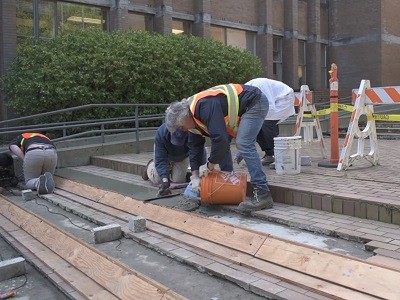
 Concrete made with recycled tires. Why didn’t anyone think of this sooner?
Concrete made with recycled tires. Why didn’t anyone think of this sooner?
Engineers at the University of British Columbia have developed more sustainable concrete by incorporating recycled tires into the mix. They think the new material could be used for structures such as buildings, roads, and bridges, while at the same time reducing waste in landfills.
Obinna Onuaguluchi, a postdoctoral fellow in civil engineering at the University of British Columbia, said the ideal combination of 0.35 per cent tire fibres and concrete materials – cement, sand, and water – was discovered after researchers experimented with other proportions.
Onuaguluchi explained compared to regular concrete, having it be fibre-reinforced reduces crack formation by more than 90 per cent, as seen in the research described in “Materials and Structures”.
“Concrete structures tend to develop cracks over time, but the polymer fibres are bridging the cracks as they form, helping protect the structure and making it last longer,” he says.
According to the UBC News article, up to three billions tires are produced annually around the world, generating almost that same number in kilograms of fibre when recycled.
UBC civil engineering professor Nemy Banthia, who supervised the work, said the final resting place for the majority of scrap tires is a landfill.
Concrete made with recycled tires reduces emissions…
“Adding the fibre to concrete could shrink the tire industry’s carbon footprint and also reduce the construction industry’s emissions, since cement is a major source of greenhouse gases,” said Banthia, who is also scientific director of UBC-hosted Canada-India Research Center of Excellence (IC-IMPACTS), which is a centre known for developing research collaborations between Canada and India.
He added almost six billion cubic metres of concrete are used each year, and this fibre can be used in every cubic metre. The new concrete was used to resurface steps on campus last month.
“Banthia’s team is tracking its performance using sensors embedded in the concrete, looking at development of strain, cracking and other factors. So far, the results support laboratory testing that showed it can significantly reduce cracking,” the article stated.
Despite this new discovery, asphalt has long been considered to be the most economically and socially beneficial means for laying roadways. According to a 2012 report by the Ontario Hot Mix Producers Association, asphalt is one of the most versatile construction materials, and has been used to pave 95 per cent of the province’s roads.
“Asphalt is North America’s most recycled material, more than aluminum, paper or plastic. Four out of every five tonnes of asphalt pavement removed for widening and resurfacing projects are reused.
“When we pave with asphalt, we put aggregate and asphalt cement resources in “the bank” to be used by future generations,” stated the report.
Furthermore, while the new method appears cost effective and beneficial in the controlled environment of its university experiment grounds, there is no way to tell if these benefits will translate effectively in the real world of construction.
Below: When the rubber hits the road: recycled tires create stronger concrete
Leave a Reply
You must be logged in to post a comment.




 Share
Share Tweet
Tweet Share
Share




Comment